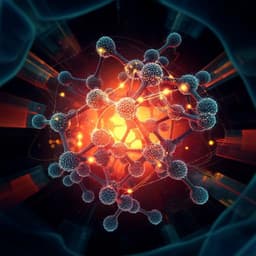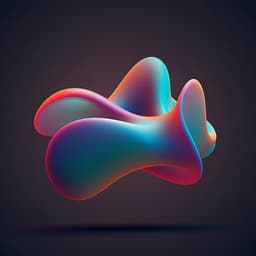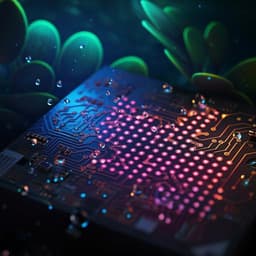
Engineering and Technology
High-resolution light field prints by nanoscale 3D printing
J. Y. E. Chan, Q. Ruan, et al.
Explore the groundbreaking advancement in light field prints (LFPs) by researchers including John You En Chan and Qifeng Ruan. This study introduces a method using two-photon polymerization lithography to create high-resolution LFPs, enhancing the clarity and realism of 3D images for print media and security applications.
~3 min • Beginner • English
Introduction
Conventional 2D prints encode only intensity and color, lacking directional control of light and thus appearing the same from all viewing angles. Light field prints (LFPs) encode directional information so that changing viewpoints yield different perspectives of a 3D scene. Despite this, current LFPs suffer from pixelation due to low spatial resolution (set by microlens spacing) and low angular resolution (set by pixel density under each microlens), as well as misalignment between lenses and color pixels. The research question is how to fabricate LFPs with simultaneously high spatial and angular resolution while ensuring precise alignment between microlenses and color pixels. The authors propose using two-photon polymerization lithography (TPL) as a one-step nanoscale 3D printing method to directly fabricate aligned microlenses and structural color pixels, aiming for unpixellated naked-eye 3D images with smooth motion parallax.
Literature Review
The concept of integral imaging with microlens arrays dates to Lippmann (1908). Autostereoscopic LFPs provide naked-eye 3D without special glasses or lasers, unlike stereoscopic prints and holograms. Prior structural color printing with plasmonic/dielectric nanostructures achieves extremely high pixel densities far beyond inkjet printing. Inkjet-based LFPs exist but lack sufficient resolution for security applications (<50 µm feature spacing) and suffer color-layer misregistration. Electron-beam lithography can position plasmonic pixels precisely, and prior work bonded microlens arrays to plasmonic color prints to create multicolor motion effects; however, this requires multiple fabrication steps and manual nanoscale alignment, which is challenging, particularly for pseudorandom layouts meant to suppress moiré. Thus, a fabrication approach that inherently aligns lenses and pixels and supports irregular arrangements is needed.
Methodology
Design: The LFP comprises display units, each consisting of a hollow support tower and a spherical plano-convex microlens positioned one focal length above a block of structural color pixels. Pixels are arrays of nanopillars made from the same low-index resin (IP-Dip, n≈1.55) as the microlenses. The LFP contains 65×65 display units arranged pseudorandomly with center-to-center spacing between 29 and 45 µm to exceed the eye's resolving power. Initial unit parameters: tower height 34.6 µm, tower diameter 26 µm, microlens diameter L=21 µm, radius of curvature R=22 µm, designed focal length F≈37–40 µm, NA≈0.28 (covering viewing angles θ=0–16°). Pixel layouts were scaled from 3×3 pixels (5×5 nanopillars per pixel, pitch P=5 µm) to 5×5 pixels (3×3 nanopillars per pixel, P=3 µm) and 15×15 pixels (single nanopillar per pixel, P=1 µm). Input images: Multiple perspective images (cube or cartoon face) were interlaced via an algorithm to map pixel positions to display units, with a 180° rotation convention to avoid pseudoscopic depth.
Simulations: Ray tracing in MATLAB to derive microlens focal length and acceptable viewing angles; using Cauchy parameters for IP-Dip (n(λ)) and evaluating aberrations (spherical, chromatic, field curvature). Microlens focal plane at z≈37 µm validated for θ=0°; field-dependent focal shift noted at θ=16°. The pixel position selected obeys x≈F tan θ. Electromagnetic simulations (FDTD, Lumerical) evaluated focal spot size at z=37 µm for λ={450, 532, 635} nm, yielding FWHM≈{0.85, 1.00, 1.19} µm, close to the diffraction limit 0.51λ/NA, and showed FWHM increases with θ. Pixel angular color stability was simulated on representative nanopillar arrays (D=0.3 µm, H=1.2 µm, S=1 µm), showing minimal spectral change from 0° to 8° and modest desaturation from 8° to 16°.
Fabrication: TPL (Nanoscribe Photonic Professional GT) in IP-Dip on fused silica. Microlenses and towers written as surface shells (20 nm slicing) and UV post-cured; nanopillars written with PulsedMode; towers/microlenses in ContinuousMode. Laser power 20 mW. Nanopillar heights varied 0.6–2.7 µm (0.3 µm steps) and exposure time 0.04–0.32 ms per voxel to tune diameters. Arrays fabricated pseudorandomly (29–45 µm spacing). Development: PGMEA 11 min, IPA 2 min with UV, nonafluorobutyl methyl ether 5 min, air dry.
Characterization: Optical microscopy (Nikon 10× NA0.2) and SEM (JEOL JSM-7600F) to inspect structures. Transmittance spectra measured to map structural color to fabrication parameters and plotted on CIE diagram. Laser setup captured focal spot images at λ={450, 532, 635} nm to measure FWHM and Strehl ratio. White LED illumination used to view LFP from various azimuth/elevation angles; macro photography documented viewpoints. Angular sampling interval ωα=arctan(P/F) analyzed for different pixel pitches. Maximum image depth estimated via I=(C F)/P with average C≈37 µm. Transmission vs reflection mode compared.
Key Findings
- One-step TPL directly fabricated aligned microlenses and structural color pixels in IP-Dip, eliminating manual alignment.
- Achieved high spatial resolution: microlens center-to-center separation 29–45 µm, below the eye’s resolving power, yielding unpixellated appearance to the naked eye.
- Achieved high angular resolution: angular sampling interval ωα≈1.6° for P=1 µm and F≈37 µm; smooth motion parallax across up to 15×15 viewpoints.
- Smallest color pixel is a single nanopillar (~300 nm diameter), demonstrating clear and colorful images even at P=1 µm (S=1 µm).
- Pixel resolution reached 25,400 dpi (single nanopillar per pixel).
- Information density estimated at 0.98 Megabits per mm² from a 64-color palette (6 bits).
- Acceptable viewing angle range ≈0–16°, with minimal color shift up to ~8° and modest desaturation by 16° (spectral trough shift 570→586 nm; transmittance increase 3→12%).
- Measured microlens focal spot sizes: FWHM≈0.88, 1.03, 1.213 µm and Strehl ratios ≈0.88–0.89 at λ=450, 532, 635 nm, approaching the diffraction limit.
- Demonstrated 3×3 (P=5 µm) and 5×5 (P=3 µm) viewpoint LFPs; reducing P increased crosstalk at transition viewpoints but improved motion parallax due to smaller ωα.
- 15×15 viewpoints with P=1 µm provided smooth motion parallax; with E=6 mm and V=150 mm, ωα≈1.6° and ω≈2.1° were below δ≈2.3°, satisfying smoothness and alleviating accommodation-vergence conflict.
- Maximum image depth (from center viewpoint) ≈1.3 mm (I=(C F)/P with C≈37 µm), total depth range ≈2.6 mm.
- Reflection-mode operation is possible but shows reduced brightness/contrast due to additional scattering and losses.
- Color gamut of IP-Dip nanopillars ~40% sRGB.
Discussion
The work addresses LFP pixelation and misalignment by leveraging TPL for co-fabrication of microlenses and structural color pixels with intrinsic nanoscale alignment. The optimized microlens design (NA≈0.28, F≈37 µm) matches the angular stability of the nanopillar color pixels (0–16°), enabling directional routing of light and viewpoint-dependent images without notable color shifts within the acceptable range. Demonstrated focal performance near the diffraction limit ensures pixels down to 1 µm can be addressed with minimal crosstalk at specified viewpoints, providing high angular resolution and smooth motion parallax across up to 225 views. The pseudorandom arrangement of display units suppresses moiré and offers potential for encoding security features. The quantitative results (25,400 dpi, ~1.6° angular sampling, 0.98 Mbits/mm², 1.3 mm depth) show that nanoscale 3D printing can simultaneously achieve high spatial and angular performance in a transmissive LFP. Trade-offs are identified between pixel pitch, crosstalk, and motion smoothness, as well as between material refractive index, color gamut, and microlens performance. Reflection mode is feasible but with reduced image quality. The approach is significant for secure, naked-eye viewable 3D images and lays groundwork for further performance enhancements.
Conclusion
The study demonstrates a one-step nanoscale 3D printing method (TPL) to fabricate high-resolution light field prints comprising aligned microlenses and structural color nanopillar pixels. It achieves unpixellated naked-eye 3D images with smooth motion parallax, high spatial resolution (29–45 µm spacing), high angular resolution (~1.6°), and pixels down to a single nanopillar (~300 nm). Quantified performance includes near-diffraction-limited microlens focusing, 25,400 dpi pixel resolution, ~0.98 Mbits/mm² information density, and ~2.6 mm total depth range. Future research should focus on scaling throughput via parallel TPL, improving materials (higher index for wider color gamut while managing dispersion/loss), optimizing lens–pixel separation and NA, enhancing angle insensitivity of pixels, integrating high-performance metalenses for wider fields of view (approaching 180°), and potentially fabricating on curved substrates to enable hyper-realistic LFPs with angular resolution ~0.4°.
Limitations
- Throughput: Serial TPL required ~24 h to print a 2 mm × 2 mm area, limiting scalability; needs parallelization for mass production.
- Structural fragility: Printed micro/nanostructures are easily damaged; protective enclosures are recommended.
- Limited color gamut (~40% sRGB) due to low refractive index IP-Dip; higher-index materials could expand gamut but risk added dispersion and reflective losses that degrade microlens performance.
- Viewing angle range limited to ~0–16°, set by pixel angular stability and microlens NA.
- Reflection mode exhibits reduced brightness/contrast due to additional scattering and interface losses.
- Design constraints: Lens–pixel separation must balance mechanical stability (aspect ratio ≲10:1) and color saturation (avoid excessive NA collecting scattered light). Crosstalk increases as pixel pitch decreases, requiring careful angular sampling vs. viewpoint spacing optimization.
Related Publications
Explore these studies to deepen your understanding of the subject.







